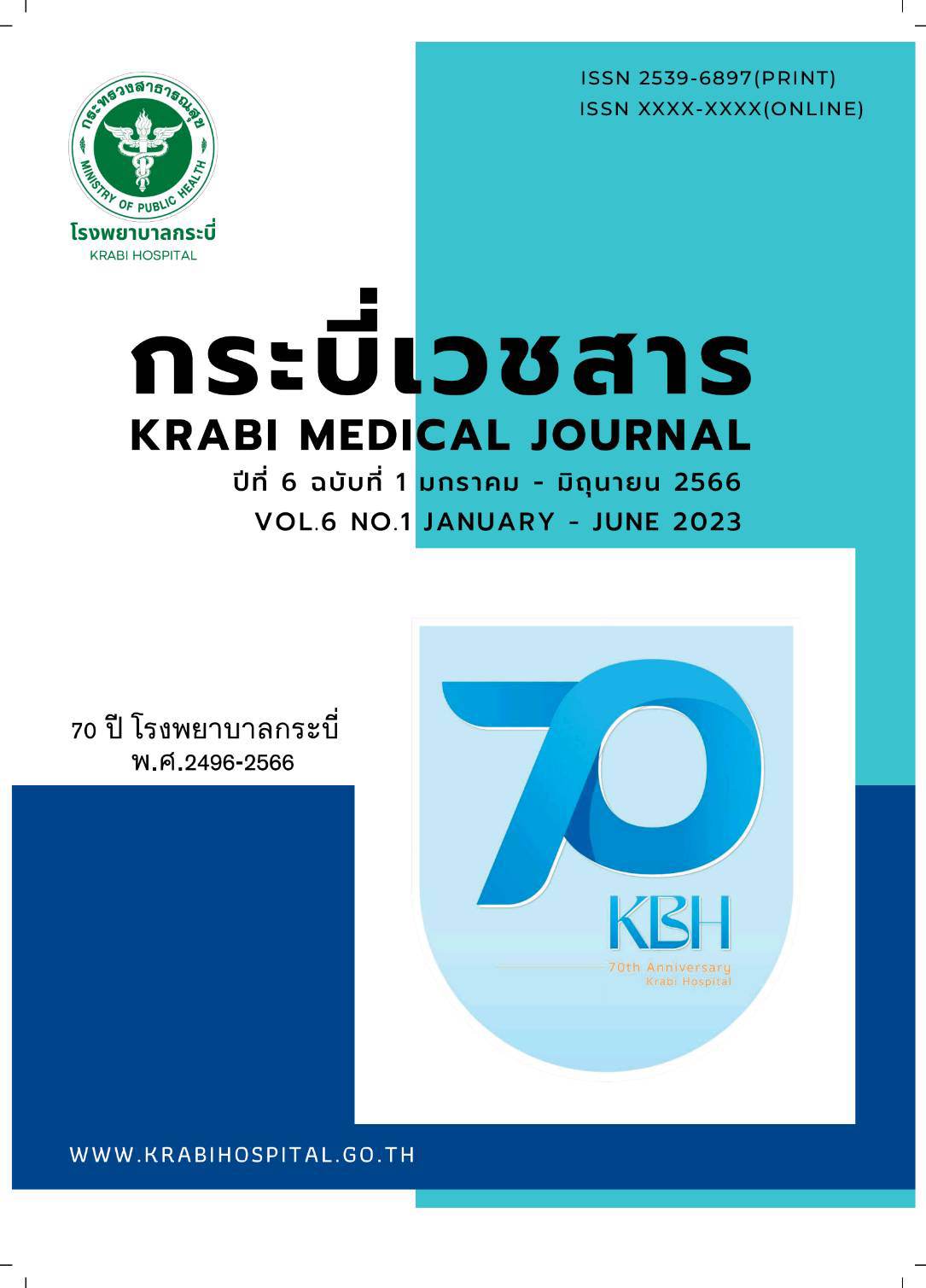Correlation factors of severity in non-variceal upper gastrointestinal bleeding in Krabi Hospital
Main Article Content
Abstract
Background: Peptic ulcers with high-risk stigmata features carry high mortality rate due to rebleeding conditions and need for urgent endoscopic hemostasis procedure. This study aimed to develop a simple tool to determine any correlation factors with high-risk stigmata features of peptic ulcers in pre-endoscopic non-variceal upper gastrointestinal bleeding patients.
Methods: This research involved a retrospective review of pre-endoscopic data from 100 patients with peptic ulcer bleeding from 1 August 2019 – 31 August 2021 at Krabi Hospital. Demographic, clinical presentation and laboratory data were compared between high-risk and low-risk stigmata peptic ulcer groups. The model scoring system was determined by using logistic regression and ROC curve to come up with a simple predictor tool that could identify high-risk stigmata of non-variceal upper gastrointestinal bleeding.
Result: Statistically significant factors were albumin < 3 g/dL, mean arterial pressure (MAP) < 80 mmHg, heart rate ≥ 90 /min and presence of fresh blood in nasogastric. Prediction Model and Scoring Algorithm for high risk stigmata cut off was 7 points with sensitivity of 78.79% and specificity of 73.13%. The area under ROC curve was 0.7596.
Conclusion: This study revealed albumin < 3 g/dL, mean arterial pressure (MAP) < 80 mmHg, heart rate ≥ 90 /min and presence of fresh blood in nasogastric correlation factors with high-risk stigmata of peptic ulcers in non-variceal upper gastrointestinal bleeding. The findings of this study can be used as a new pre-endoscopic predictor tool for identifying patients at high risk of rebleeding.
Article Details

This work is licensed under a Creative Commons Attribution-NonCommercial-NoDerivatives 4.0 International License.
บทความนิพนธ์ต้นฉบับจะต้องผ่านการพิจารณาโดยผู้ทรงคุณวุฒิที่เชี่ยวชาญอย่างน้อย 2 ท่าน แบบผู้ทรงคุณวุฒิ และผู้แต่งไม่ทราบชื่อกันและกัน (double-blind review) และการตีพิมพ์บทความซ้ำต้องได้รับการอนุญาตจากกองบรรณาธิการเป็นลายลักษณ์อักษร
ลิขสิทธิ์
ห้ามนำข้อความทั้งหมดหรือบางส่วนไปพิมพ์ เว้นว่าได้รับอนุญาตจากโรงพยาบาลเป็นลายลักษณ์อักษร
ความรับผิดชอบ
เนื้อหาต้นฉบับที่ปรากฏในวารสารเป็นความรับผิดชอบของผู้เขียน ทั้งนี้ไม่รวมความผิดพลาดอันเกิดจากเทคนิคการพิมพ์
References
Alzoubaidi, D and L.B. Lovat (2018). “Management of non-variceal upper gastrointestinal bleeding: where are we in 2018?” Frontline Gastroenterology 10 :35–42.
Amandeep, K. and S. Robin (2012). "PEPTIC ULCER: A REVIEW ON ETIOLOGY AND PATHOGENESIS." INTERNATIONAL RESERCH OF PHARMACY 3: 34-38.
Chopra/Rosenberg/Moayyedi/Narula (2019).” Is Blood Urea Concentration an Independent Predictor of Positive Endoscopic Findings in Presumed Upper Gastrointestinal Bleeding?.” Digestive Disease. DOI: 10.1159/000501549.
Fukuda et al (2019). “Risks for Rebleeding and In-Hospital Mortality after Gastrointestinal Bleeding in a Tertiary Referral Center in Japan.” Digestion. DOI: 10.1159/000504088
Gralnek, I. M. and J.-M. Dumonceau (2015). "Diagnosis and management of nonvariceal upper gastrointestinal hemorrhage: European Society of Gastrointestinal Endoscopy (ESGE) Guideline." ESGE Guideline ... Endoscopy 2015 47: a1-a46.
JY, L., et al. (1998). "The evolution of stigmata of hemorrhage in bleeding peptic ulcers: a sequencing endoscopic study." Endoscopy 30(6).
Kim, M. S. and H. S. Moon (2020). "Validation of a new risk score system for non-variceal upper gastrointestinal bleeding." BMC Gastroendoscopy.
Lai, Y., et al (2022). “Development and validation of a model to predict rebleeding within three days after endoscopic hemostasis for high-risk peptic ulcer bleeding.” BMC Gastroenterology 22:64.
Laine, L. and A. N. Barkun (May 2021). "ACG Clinical Guideline: Upper Gastrointestinal and Ulcer Bleeding." CLINICAL GUIDELINE 116(5): 899-917.
R, R., et al. (2016). "The Predictive Value of Preendoscopic Risk Scores to Predict Adverse Outcomes in Emergency Department Patients With Upper Gastrointestinal Bleeding." Acad Emerg Med.
Samreen, S. and M. Khurram (Oct-Dec 2016). "Diagnosis accuracy of high risk Glasgow Blatchford score and need for endoscopic intervention in upper gastrointestinal bleeding." Rawal Medicine Journal 41(4).
SangchanA, et al. (2012). "Hospitalized Incidence and Outcomes of Upper Gastrointestinal Bleeding in Thailand." Journal of the Medical Association of Thailand 95: S190-S195.
S.M. Bitar and M. Moussa (2022). “The risk factors for the recurrent upper gastrointestinal hemorrhage among acute peptic ulcer disease patients in Syria: A prospective cohort study” Annals of Medicine and Surgery 74.
Sung, J. J. and P. W. Chiu (2019). "Asia-Pacific working group consensus on non-variceal upper gastrointestinal bleeding: an update 2018." British journal of medicine 67(10).
Wang, J. and D. Hu (2016). "Simple Risk Factors to Predict Urgent Endoscopy in Nonvariceal Upper Gastrointestinal Bleeding Pre-endoscopically." Clinical Gastroenterology and Hepatology 15(1): E16-E17.
Wierzchowski, P. and S. Dabrowlecki (2011). "Nonvariceal ulcer upper gastrointestinal tract bleeding-the risk factors and the value of emergency endoscopy." CLINICAL RESEARCH.

